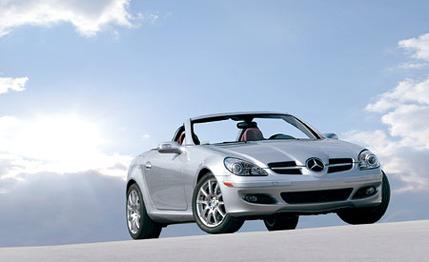 Road Test
Road Test
After years of selling über-expensive SL roadsters to the wealthy, in 1997 Mercedes-Benz surprised the car-buying public by offering a retractable-hardtop roadster as visually stunning as the SL, but at 50 percent off. The car was the $40,000 SLK, whose dashing looks promised sports-car performance, although in reality it was more a boulevardier than a track-ready player.
Despite the SLK's lack of tire-spinning sports-car virtues, Mercedes had a hit on its hands as status seekers with less astonishing budgets quickly snapped up the first few years' worth of production. Sustaining the furor proved a bit difficult as the SLK aged quickly in its ever-evolving segment. The entirely redesigned second generation will surely revive the excitement, not because of its price, but because it is now a driver's car.
Fire up the SLK350, and what you'll notice is the mechanical symphony played by the dual exhaust. The previous SLK's 185-hp, 2.3-liter supercharged four-cylinder engine never sounded this good. Its engine beat out a sound that was more popcorn popper than sports car. Exhaust tuning was clearly not a priority on the first SLK, although the later six-cylinder model improved matters significantly. Now that Mercedes is serious about building a sports car, the SLK gets an eager, percussive exhaust note that increases in alacrity when the engine is playing hard. Your ears will now agree that the SLK sounds the part.
The engine responsible for this dulcet opus is a 268-hp, 3.5-liter V-6. Based on the 215-hp, 3.2-liter 90-degree V-6 from last year's SLK320, the 3.5-liter ditches the three-valve twin-plug SOHC heads in favor of DOHC single-plug four-valve heads with variable valve timing on the intake and exhaust valves. The extra displacement comes from an increase in bore and stroke, and new pistons contribute to a bump in the compression ratio from 10.0:1 to 10.7:1. As in the 3.2-liter, a balance shaft keeps the harmonically challenged 90-degree V-6 spinning happily to its 6200-rpm redline.
The revised mill is rotary-smooth and blessed with a constant stream of 258 pound-feet of torque from 2400 to 5000 rpm that provides excellent 30-to-50- and 50-to-70-mph top-gear passing times. Power delivery at any rpm is quick and effortless, and the thrust never seems to taper off. If you don't keep an eye on the tachometer, you're sure to run into the 6500-rpm fuel cutoff in the short first and second gears. This is a seductively sporty engine that accelerates the SLK to 60 mph in 5.3 seconds-0.2 second quicker than a Nissan 350Z Touring and a whopping 1.5 seconds quicker than the SLK320. Hang on for 13.8 seconds, and the quarter-mile will pass at 103 mph on its way to a redline-limited top speed of 161 mph. (Why our tester ran to 161 instead of a governed 155 is a mystery.)
Mercedes offers its seven-speed automatic, dubbed the 7G, on its new roadster, but our SLK350 had a precise and rewarding six-speed manual. The shifter feels like the love child of a Honda S2000 and BMW M3. There's a slightly rubbery feel as in the M3, and the throws aren't quite as short as the S2000's, but the effort is light and positive. Shift as fast as you like, because the gearbox synchros feel unbeatable. Pedal placement is good, although the smaller-shoed will wish the brake pedal were just a bit closer to the accelerator to facilitate heel-and-toe downshifts. It's easy to match revs in the SLK, as the engine responds instantly to accelerator contact, and unlike most modern engines, the SLK loses revs quickly. The engine has a willing personality that is perfectly suited to a manual transmission-you'll definitely not regret choosing it over the automatic. The conventional wisdom has always been that Mercedes reluctantly developed light and sloppy manual gearboxes for taxi drivers instead of enthusiasts. Clearly, that notion can be put to pasture as the SLK's gearbox is good enough to make everyone happy.
Two beneficial Mercedes traits that have carried over are a rigid body structure and strong, fade-free brakes. Stops from 70 mph are drama-free and use up 167 feet. Brake-pedal feel is excellent; the SLK has traditional hydraulic brakes instead of the brake-by-wire Sensotronic system that is difficult to modulate. A tight structure has always been a Mercedes strength, and the first-generation SLK was blessed with a structure that was largely quiver-free. According to the front office, the new generation increases torsional rigidity by 46 percent and bending stiffness by 19 percent. High-strength steel is used liberally and to good effect: Over even the worst expansion joints, railroad tracks, and potholes, the SLK shoulders the blows with ease.
Attached to the stiff structure are a strut front suspension and a multilink rear suspension. Even with staggered gumballs, 225/45R-17s in front and 245/40R-17s in back, the SLK resists understeer unlike any other Mercedes. At low speeds, power oversteer is readily available, and at higher speeds, you'll find some reassuring understeer, but it's never of the terminal variety. Grip is plentiful at 0.87 g, and roll is kept in check. The ride is now sports-car stiff, but the SLK will absorb large impacts without jarring the occupants. Toss it through a few corners, and it immediately feels smaller than its predecessor, despite its larger dimensions.
The car's new steering system contributes greatly to the chuckable feel. Mercedes has finally purged itself of the numb recirculating-ball steering that was too fast off-center and incommunicado after that. The new rack-and-pinion setup talks to the hand as readily as a guest on Jerry Springer. Unlike Jerry's guests, though, the wheel speaks clearly, predictably, and without anger.